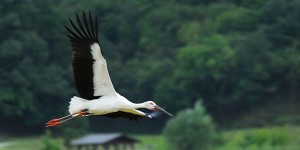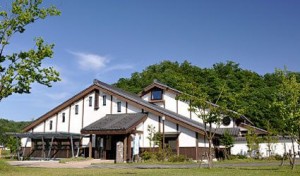From 17-19 August this year, the Mayor of Toyooka, Hyogo Prefecture, Mr Muneharu Nakagai visited the Birdfair event at Rutland Water, to give a presentation on the reintroduction of Oriental White stork in the city.
Mayor Nakagai, who is personally deeply committed to preservation of the species, and staff members from Toyooka City Hall introduced the details of the reintroduction and its role in promoting tourism to Toyooka, especially Kinosaki Onsen which is a famous and picturesque town, built along a willow-lined river, and is one of the top onsen destinations of the Kansai Region.
Reviving Japan’s once-extinct stork population is not just a story of conservation in the city but It is also about a provincial region reinventing itself to prevent its population following the species into endangered status. In common with many regions nationwide, Toyooka has suffered from emigration and the loss of prosperity to bigger urban areas.
Facing the Sea of Japan and thickly forested, Toyooka boasts a range of tourist spots, including ski slopes and the Kinosaki hot springs. But of its approximately 85,000 residents, over 28 percent are aged 65 or over, the city reports on its website.
Hot springs were discovered in Kinosaki around the eighth century and since then the town has developed into a charmingly old-fashioned onsen town. In the evenings guests of the local ryokan stroll about town in yukata and geta (wooden clogs), visiting the numerous public baths and nostalgic game arcades.
Toyooka City Hall has been involved for over a decade in the preservation and reintroduction of the Oriental White Stork. Several land areas in Toyooka have been designated wildlife reserves and are used to help reintroduce the Oriental White Stork back into the wild. Two of the main reserves are the Hyogo Park of the Oriental White Stork in Toyooka and Hachigoro Toshima Wetlands in Kinosaki Onsen. Both are open to the public and provide educational information on the Oriental White Stork, recommended for families with small children.
The reintroduction of the Oriental White Stork came about after years of decline in the population in Japan. The Oriental White Stork had once lived in the wild, but in 1971 the last wild Oriental White Stork disappeared from the skies of Japan. Toyooka City created a breeding and research facility to begin breeding and raising them in captivity. In 2005, they were successfully reintroduced into the wild for the first time. Currently, about 90 Oriental White Storks fly majestically in the skies of Toyooka and the city hall continues to have a role in preserving their habitat.
Mayor Nakagai gave a presentation at the Birdfair event which was accompanied by a documentary, details of which can be seen here
Mayor Nakagai and staff from Tooyoka also put out a stall at the Birdfair exhibition event, telling the story of Oriental White stork and tourism of Toyooka, showing photos of Oriental White storks and showing visitors how to make Origami Oriental White Stork like the famous ‘tsuru’ crane.
More details about the project can be seen on Japan’s Ministry of Environment website HERE.
As well as on the Tooyoka City Hall tourist information website HERE.
Pictures copyright Tooyoka City Hall



